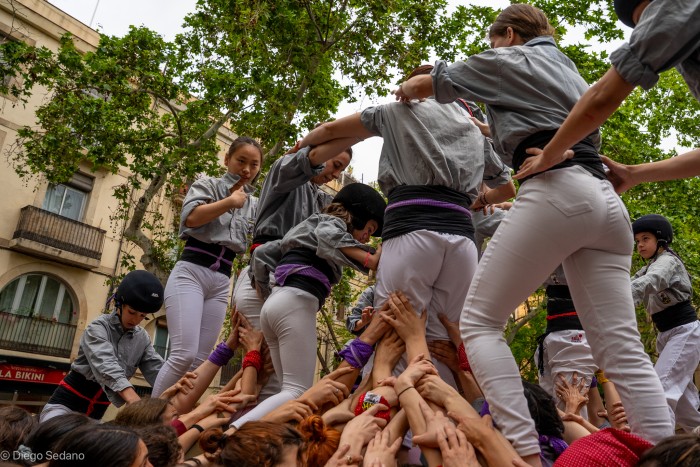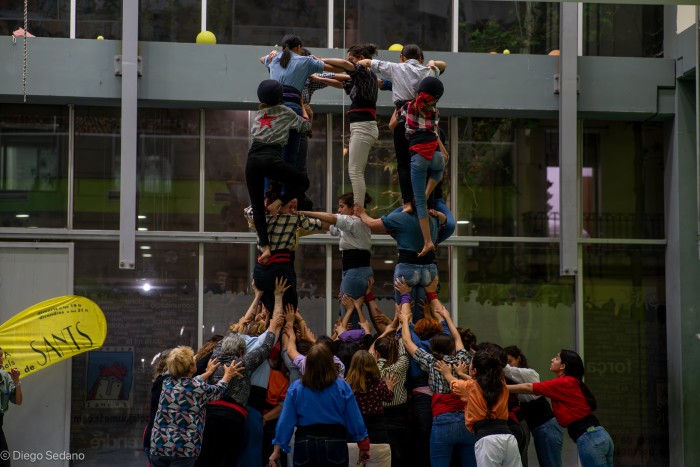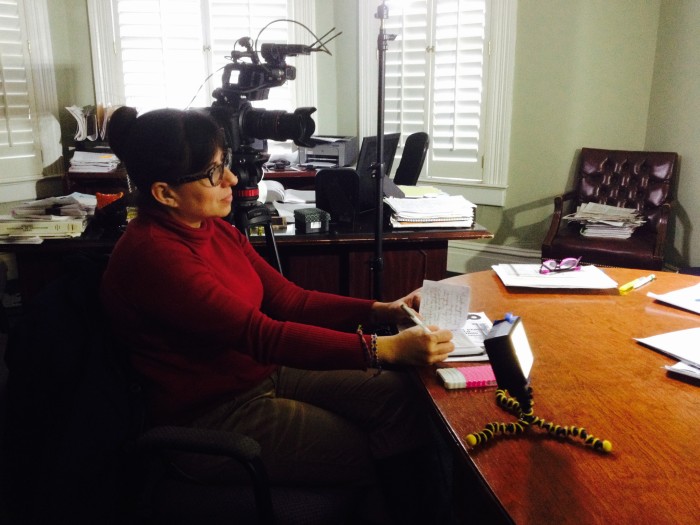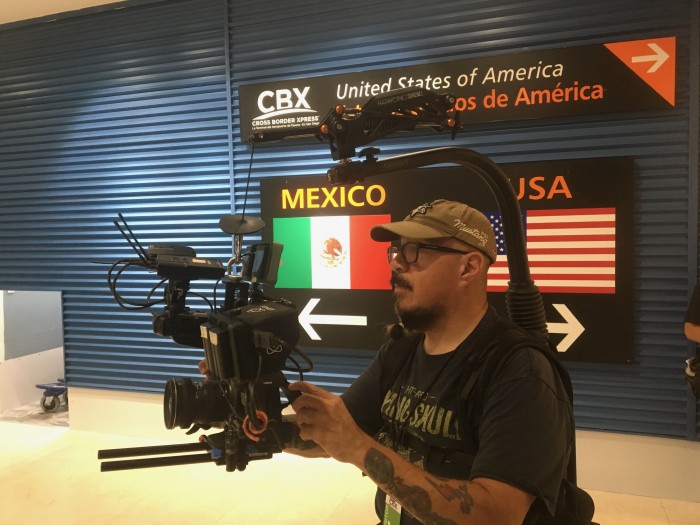Contributing £ 9
Each Drop Adds Up
With your help, we're one step closer to making this documentary a reality.
Thank you for joining us on this journey!
- A personal thank-you letter is on its way to you!
> 15 Co-financiers
Goteo ha construido una historia única en el mundo del micromecenazgo. ¿Quieres seguir formando parte de ella?
You have to sign in to see this page
Pit i Ovaris, Les Dones Castelleres de Sants

 Min.
Min.
 Opt.
Opt.
With your help, we're one step closer to making this documentary a reality.
Thank you for joining us on this journey!
As a token of our gratitude, you will receive a personalized thank-you letter and a downloadable casteller photo from the director’s archive — a unique glimpse into the heart of this powerful tradition.

As a token of our gratitude, you’ll receive a personalized thank-you letter and two downloadable casteller photos from the director’s archive — a unique window into the strength, beauty, and tradition of this cultural practice.


You’ll receive a special thank-you credit in the film’s end credits, plus your choice of either an embroidered bandana or a tote bag printed with the Sants colla logo — a meaningful keepsake from this incredible community.


You’ll receive a special thank-you credit in the film’s end credits, plus your choice of either an embroidered bandana or a tote bag printed with the Sants colla logo — a meaningful keepsake from this incredible community.
Additionally, you’ll get one ticket to the documentary premiere with the Sants colla, where you can experience the film alongside the castellers themselves.


You’ll receive a special thank-you credit in the film’s end credits, plus your choice of a bandana or tote bag featuring the Sants colla logo.
Additionally, you’ll get one 15x20 cm printed casteller photo from the director’s archive on regular paper, and one ticket to the documentary premiere with the Sants colla, where you can watch the film alongside the castellers themselves.



You will receive an Associate Producer credit in the film, plus your choice of a bandana or tote bag featuring the Sants colla logo.
Additionally, you’ll get a 15x20 cm Fine Art print of a casteller photo from the director’s archive, printed on high-quality paper, and two tickets to the documentary premiere with the Sants colla, where you can enjoy the screening alongside the castellers themselves.



Associate Producer Credit
Sants Colla Bandana or Tote Bag
Fine Art Prints
Four Premiere Tickets
You will receive an Associate Producer credit in the film, plus your choice of a bandana or tote bag featuring the Sants colla logo.
Additionally, you’ll get two 15x20 cm Fine Art prints of casteller photos from the director’s archive, printed on high-quality paper, and four tickets to the documentary premiere with the Sants colla, where you can enjoy the screening alongside the castellers themselves.




You will receive an Associate Producer credit in the film, and your company’s logo will be displayed on screen.
Additionally, you’ll get your choice of a bandana or tote bag featuring the Sants colla logo, two 15x20 cm Fine Art prints of casteller photos from the director’s archive printed on high-quality paper, and four tickets to the documentary premiere with the Sants colla, where you can enjoy the screening alongside the castellers themselves.




In this story, women are not princesses; they are the castle. Get to know the strength of the women from the Sants Castells team.
 Task
Task
|
Minimum | Optimum |
|---|---|---|
|
Editing
-Logging and organizing the footage.
-Transcribing interviews.
-Assembling the material.
Editing is a fundamental part of the documentary process, essential for creating a coherent narrative for the viewer.
|
£ 2,973 | |
|
Video Post-Production
Color correction: Adjusts the colors of the different shots and creates an aesthetic style that unifies the documentary.
Graphic design: Graphic elements that support the narrative, including titles and credits.
|
£ 2,886 | |
|
Audio Post-Production
Audio post-production: Dialogues, sound effects, ambient sounds, and music come together to create the soundtrack.
Audio remastering: Mixing all the elements of the soundtrack.
Library music or original music: Depending on the amount raised, we will choose either library music or create original music.
|
£ 2,798 | |
|
Original Music
Original music composed specifically for the documentary.
|
£ 1,749 | |
|
2D or 3D Animation
2D or 3D animation. Depending on the funds raised, we will create animations to help explain the positions of the members within a castell.
|
£ 1,312 |
 Material
Material
|
Minimum | Optimum |
|---|---|---|
|
Post-Production
Storage drives: We need external hard drives to create at least three backup copies of the filmed material.
|
£ 2,186 |
 Infrastructure
Infrastructure
|
Minimum | Optimum |
|---|---|---|
|
Commissions, Transfers, and Shipping
This campaign incurs additional costs, such as bank fees, PayPal fees, platform fees that make this project possible, as well as the costs of rewards and their shipping.
|
£ 1,836 | |
|
Fees, Transfers, and Shipping
This campaign incurs additional costs, including bank fees, PayPal fees, platform fees that make this project possible, as well as the costs of rewards and their shipping.
|
£ 1,312 | |
| Total | £ 12,680 | £ 17,053 |
Every two years, the Concurs de Castells is held in Tarragona, where the best castells teams from Catalonia compete. This documentary offers an intimate, feminist perspective on the girls, teenagers, and adult women who are part of the Sants team in Barcelona. It follows their daily lives, their participation in rehearsals, and their preparations for the Concurs de Castells 2024, alongside their motivations, dreams, fears, and the history of the Sants neighborhood. It tells a legacy of empowerment, roots, and identity—the heritage of the textile workers’ struggle in the neighborhood, passed down to the women of the Sants castells team.
Pit i Ovaris, the Women of the Sants Castells Team, is a documentary that will tell the story of the girls, teenagers, and adult women of the team, with the aim of highlighting their role in the cohesion and strength of the castells tradition— a role that has often been overlooked due to the projection of castells as a “male” activity, largely because of the physical strength it involves.
In this regard, Pit i Ovaris proposes a shift in perspective and calls for a reevaluation of the role of women in contemporary castells.
There are two features that make the Sants team unique. One of them is its strong family and neighborhood composition. The other, linked to the first, is the emphasis on safety and doing things well in the daily narrative of the team. The Borinots —and Borinotas— do not build a castell just to earn points, but to complete it, because what matters is the feina ben feta (well-done work). In this process, the role of women is essential. The girls who climb to the top of the castell as enxaneta or acotxadora; the two young women who, as they grew up, became dosos; the women who, over the years, became cap de canalla or cap de colla; and the older women, like Lali, who in the late 90s became president of the team — something rare in an environment then dominated by men — are the ones who have made the castells higher and stronger. However, when the media talks about castells, women often have less visibility, and their names are rarely mentioned or they are rarely presented as the protagonists. The women of the team are also the ones who proudly remember the role of the workers in the old textile factories of Sants, Hostafrancs, and La Bordeta, explaining that the Borinota shirt is grey in honor of those workers.
Objectives:
To claim the role of women in the castells tradition.
To raise the visibility of the participation of girls, young women, and adult women who are part of the Colla Castellera de Sants, putting them at the center of the conversation and visual discourse about the practice of castells. This will reflect the dynamics of interaction and the values of their neighborhood and community, and show the contribution of the inclusion of women in castells culture.
To establish a connection between the history of Sants, a working-class neighborhood and the birthplace of an important chapter in the struggle for women’s labor rights in Barcelona, and the Colla Castellera de Sants, an organization where family and neighborhood life is the core not only of its members' artistic and cultural development but also of the construction of their identity within and outside the team, in the neighborhood, and in other aspects of their personal lives.
To portray the girls, teenagers, and adult women of the Colla Castellera de Sants, the Borinotas, emphasizing the continuity of family participation, especially of women, over the three decades of the team’s existence, and how they understand discipline, effort, self-esteem, and the safety net of the community.
To spark a conversation that will continue and grow over the next few years, a conversation where women are the protagonists.
To showcase the tradition of castells beyond Catalonia.


This documentary aims to first appeal to those who live in the Sants district and the city of Barcelona, inviting them to discover the women from the Sants Castells team from a different perspective. However, it is conceived as a project with international reach. The universal values presented in this documentary resonate with audiences worldwide, at a time when the equal participation of women in sports traditionally seen as male-dominated has become a necessary topic of conversation. This conversation is reflected in calls for wage equality, better media representation, and recognition of women's contributions to productive and market dynamics. The goal is for the documentary to be distributed internationally and participate in the circuit of documentary film and video festivals in Europe and other international spaces.


Diego Sedano, director and photographer, has an extensive career as a documentary filmmaker. Diego has dedicated more than two years to photographing Castells, primarily focusing on the Sants team – the Borinots. During this time, he attended all their rehearsals and performances, got to know its members, and discovered that this team is different from the others; there, among the Borinotas, was a story to tell.
Eileen Truax, a well-known journalist, is also a screenwriter and interviewer.
Eileen and Diego have worked together on projects for more than 20 years. They founded Malaespina Producciones in Los Angeles, CA, a production company dedicated to creating documentaries about immigrant communities in the United States, as well as commercials for Spanish-language television. Part of the team used for the production of this documentary comes from that company.
The documentary is 80% complete. The funds raised will go toward covering postproduction costs.


Pit i Ovaris, the Women of the Sants Castells Team, is a story about the role that girls, teenagers, and adult women play both in a castell competition and within their own team. But it is also a story of roots and wings, of community and cultural identity, and of female empowerment. The universal values presented in this documentary resonate with audiences worldwide at a time when the equal participation of women in sports traditionally seen as male-dominated has become a necessary topic of conversation. This conversation is reflected in demands for wage equality, better image representation, and recognition of women's contributions to productive and market dynamics. In this regard, we believe this is a universal story that sends an inspiring message to girls and teenagers, and also calls attention to those in other disciplines or sports about the importance of recognizing and revaluing the role of women in these activities.
Each Drop Adds Up
With your help, we're one step closer to making this documentary a reality.
Thank you for joining us on this journey!
> 15 Co-financiers
Pinya
As a token of our gratitude, you will receive a personalized thank-you letter and a downloadable casteller photo from the director’s archive — a unique glimpse into the heart of this powerful tradition.

> 22 Co-financiers
Tap
As a token of our gratitude, you’ll receive a personalized thank-you letter and two downloadable casteller photos from the director’s archive — a unique window into the strength, beauty, and tradition of this cultural practice.


> 08 Co-financiers
Folre
You’ll receive a special thank-you credit in the film’s end credits, plus your choice of either an embroidered bandana or a tote bag printed with the Sants colla logo — a meaningful keepsake from this incredible community.


> 50 Co-financiers
Manilles
You’ll receive a special thank-you credit in the film’s end credits, plus your choice of either an embroidered bandana or a tote bag printed with the Sants colla logo — a meaningful keepsake from this incredible community.
Additionally, you’ll get one ticket to the documentary premiere with the Sants colla, where you can experience the film alongside the castellers themselves.


> 04 Co-financiers
Puntals
You’ll receive a special thank-you credit in the film’s end credits, plus your choice of a bandana or tote bag featuring the Sants colla logo.
Additionally, you’ll get one 15x20 cm printed casteller photo from the director’s archive on regular paper, and one ticket to the documentary premiere with the Sants colla, where you can watch the film alongside the castellers themselves.



> 20 Co-financiers
Dosos
You will receive an Associate Producer credit in the film, plus your choice of a bandana or tote bag featuring the Sants colla logo.
Additionally, you’ll get a 15x20 cm Fine Art print of a casteller photo from the director’s archive, printed on high-quality paper, and two tickets to the documentary premiere with the Sants colla, where you can enjoy the screening alongside the castellers themselves.



> 03 Co-financiers
Acotxador
Associate Producer Credit
Sants Colla Bandana or Tote Bag
Fine Art Prints
Four Premiere Tickets
You will receive an Associate Producer credit in the film, plus your choice of a bandana or tote bag featuring the Sants colla logo.
Additionally, you’ll get two 15x20 cm Fine Art prints of casteller photos from the director’s archive, printed on high-quality paper, and four tickets to the documentary premiere with the Sants colla, where you can enjoy the screening alongside the castellers themselves.




> 00 Co-financiers
Enxaneta
You will receive an Associate Producer credit in the film, and your company’s logo will be displayed on screen.
Additionally, you’ll get your choice of a bandana or tote bag featuring the Sants colla logo, two 15x20 cm Fine Art prints of casteller photos from the director’s archive printed on high-quality paper, and four tickets to the documentary premiere with the Sants colla, where you can enjoy the screening alongside the castellers themselves.




> 02 Co-financiers